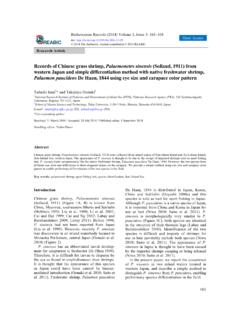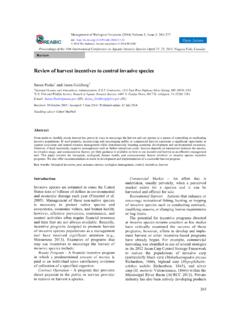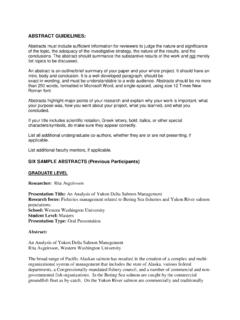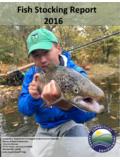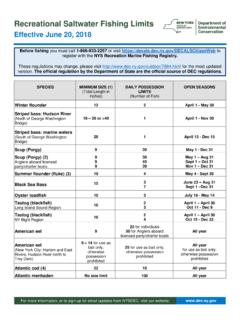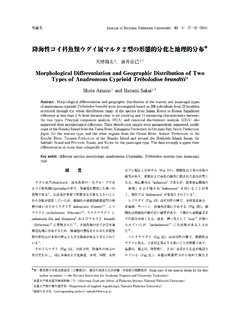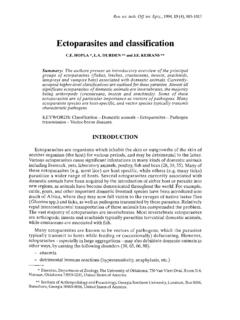Transcription of Eradication of Gyrodactylus salaris infested Atlantic ...
1 Management of Biological Invasions (2018) Volume 9, Issue 1: 67 77 DOI: 2018 The Author(s). Journal compilation 2018 REABIC Open Access 67 Research Article Eradication of Gyrodactylus salaris infested Atlantic salmon (Salmo salar) in the Rauma River, Norway, using rotenone Roar Sandodden1,*, Matt Brazier2, Morten Sandvik3, Asle Moen1, Anveig Nordtug Wist1 and P l Adolfsen1 1 Norwegian Veterinary Institute, section for Environmental Restoration and Management, Pb. 5695 Sluppen, NO-7485 Trondheim, Norway 2 Environment Agency, National Fisheries Services, Bridge End Depot, Causeway Road, Levens, Kendal, Cumbria, LA8 8EP UK 3 Norwegian Veterinary Institute, section for Chemistry and Toxicology, Pb 750 Sentrum, NO-0106 Oslo, Norway Author e-mails: (RS), (MB), (MS), (AM), (ANW), (PA) *Corresponding authorReceived: 13 February 2017 / Accepted: 18 September 2017 / Published online: 17 October 2017 Handling editor: Matthew Barnes Abstract The invasive alien ectoparasite Gyrodactylus salaris is one of the greatest threats to wild Atlantic salmon (Salmo salar) in Norway.
2 Since its introduction in the 1970s the Norwegian Environmental Authorities have applied a piscicide based Eradication strategy, using rotenone to eradicate the host species, Atlantic salmon and the parasite. After refining the methods and techniques following several unsuccessful treatments, the program has become a success and a total Eradication of G. salaris from Norway now seems possible. This paper describes the methods and techniques used in this program during a large Eradication operation conducted in the Rauma infection zone in central Norway using different land based peristaltic and boat mounted pumps in combination with continuous drip stations and gardening cans. The Eradication was performed in 2013 and 2014 and involved six infected rivers.
3 The largest river, the river Rauma has an anadromous section of 42 kilometers and consists of both rugged fast flowing areas and slow flowing parts characterized by laminar water currents. The piscicide, CFT-Legumine , containing active rotenone was applied at a dose of 1 mg/l using a range of application methods aiming to achieve concentrations of mg/l rotenone. To ensure target concentrations were met, rotenone concentrations were monitored using liquid chromatography with UV detection in all treated river in an on-site lab on a daily basis. Target concentration was reached in all treated rivers and while investigations are ongoing, to date they indicate Eradication has been effective. Key words: invasive alien species, CFT-Legumine, fish control, liquid chromatography, piscicide Introduction The Atlantic salmon parasite Gyrodactylus salaris (Malmberg, 1957) was introduced to Norway during the 1970s on infected Atlantic salmon from Sweden.
4 It is one of the greatest threats to wild Norwegian Atlantic salmon (Salmo salar Linnaeus, 1758) (The Norwegian Environment Agency 2014). Average mortality of juvenile Atlantic salmon in studied rivers is estimated to be 86%, with up to 99% mortality in the worst affected populations (Johnsen et al. 1999). Locally adapted Atlantic salmon stocks are typically on the brink of extinction 4 6 years after introduction of the parasite (Johnsen et al. 1999), leading also to severe negative impact for local fishing tourism, recreation and business. Infected rivers pose a serious and continuous risk of spreading the parasite to neighboring river systems. G. salaris is a monogenean ectoparasite with no intermediate hosts (Olstad 2013).
5 Other than Atlantic salmon, G. salaris can survive and reproduce on rainbow trout (Oncorhynchus mykiss Walbaum, 1792), Arctic char (Salvelinus alpinus Linnaeus, 1758), North American brook trout (Salvelinus fontinalis Mitchill, 1814), Arctic grayling (Thymallus thymallus Linnaeus, 1758), North American lake trout (Salvelinus R. Sandodden et al. 68 namaycush Walbaum, 1792) and brown trout (Salmo trutta Linnaeus 1758) (in declining order of suscep-tibility (Bakke et al. 2002, 2007). The only possible hosts present in the infected rivers described are Atlantic salmon and brown trout. The effect of G. salaris on Atlantic salmon is characterized by severe infections. Not much is known about the disease Gyrodactylosis and the cause of death in infected individuals, but secondary infections in wounds from attachment and feeding are assumed to be important (Olstad 2013).)
6 Often several thousand parasites infect individual fish. Mortality probably results from a combination of Saprolegnia spp. infection (Johnsen 1978; Olstad et al. 2006) and penetration of the skin which coupled with feeding activity leads to osmoregulation imbalance (Pettersen et al. 2013). G. salaris was first identified within the Rauma infection zone in 1980, in the river Henselva. The parasite was subsequently detected in the rivers Rauma (1980), Istra (1982), Skorga (1982), M na (1985) and Innfjordselva (1991). An attempted era-dication was performed in September 1993 (Asp s 1994). This attempt failed, and the parasite was rediscovered in river Rauma in September 1996 (Mo et al.)
7 1997). It is believed that the failure was the result of G. salaris infected Atlantic salmon surviving in ground water upwelling areas about 20 km from the river outlet (Johnsen et al. 2008). The aim of the Norwegian environmental authorities is a total Eradication of G. salaris in Norway and they have developed a strategy accordingly (The Norwegian Environment Agency 2014). Because of the strong host dependency, Eradication of infected fish has been used as a method to remove G. salaris from infected rivers. G. salaris can only survive for a short time period without a host (Olstad 2013). To date, the only successful method to achieve this has been the application of rotenone based piscicides.
8 CFT-Legumine containing liquid rotenone is the most common formulation used today. Rotenone has been widely used in Norway, especially over the last two decades. Infected rivers are grouped into zones. Infected zones are defined as the geographical area in which infected juvenile fish can move naturally. The parasite has been introduced to a total of 49 rivers in 17 infection zones. Of these 49 infected rivers, 22 have been treated and are parasite free, 18 have been treated and await Eradication confirmation and 9 rivers are still untreated and infected (Anon 2015). Rotenone is a naturally occurring substance derived from the roots of tropical plants in the Leguminosae family (USEPA 2007) and has been used for centuries to capture fish for food in Southeast Asia and South America where these plants naturally occur (McClay 2000; Ling 2003).
9 Rotenone is poisonous to organisms to varying degrees, but gill-breathing species are particularly vulnerable. Rotenone is rapidly absorbed across the gill epithelium and blocks oxygen use by cells (Koopman et al. 2005). Rotenone is highly toxic to fish and certain inver-tebrates (Fukami et al. 1969). Vinson et al. (2010) reviewed the effects of rotenone treatments on invertebrate communities and showed that sensitivity to rotenone varies considerably between taxonomic groups. Studies show that aquatic invertebrates typically experience a dramatic short term reduction in abundance (Arnekleiv et al. 2001). The reestab-lishment of most taxa is rapid and often complete after a year (Eriksen et al.)
10 2009; Arnekleiv et al. 2015). A comprehensive invertebrate survey before, following and after CFT-Legumine treatments was performed in the river Rauma. Rotenone is non-persistent in the aquatic environment and is degraded by photolysis and hydrolysis (Finlayson et al. 2014). An essential part of a G. salaris Eradication program is the reintroduction of the native fish stocks affected by the rotenone treatment. This strategy involves the use of both living genebank and milt bank. The purpose of living genebank is to establish a reservoir of genetic material which can be used for the reestablishment or enhancement of threatened stocks. The living genebank is based on the principal of eggs in eggs out.
